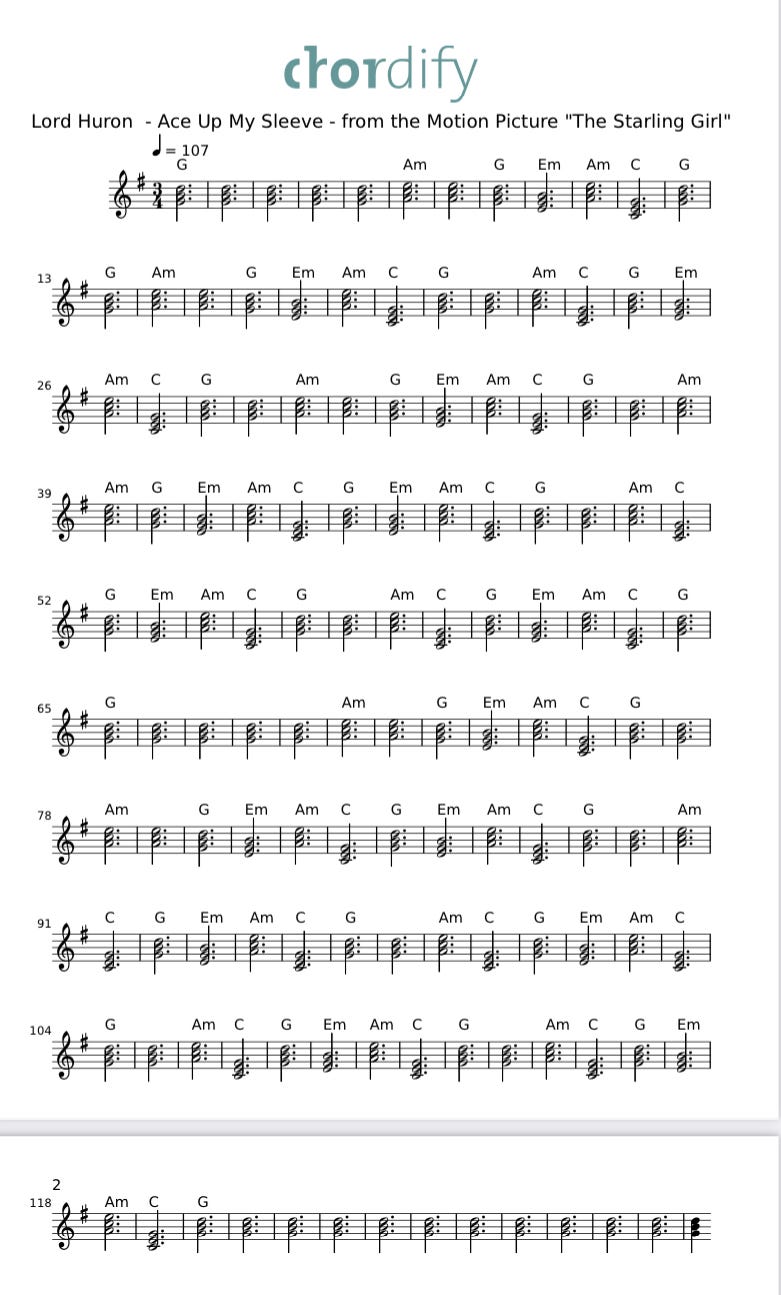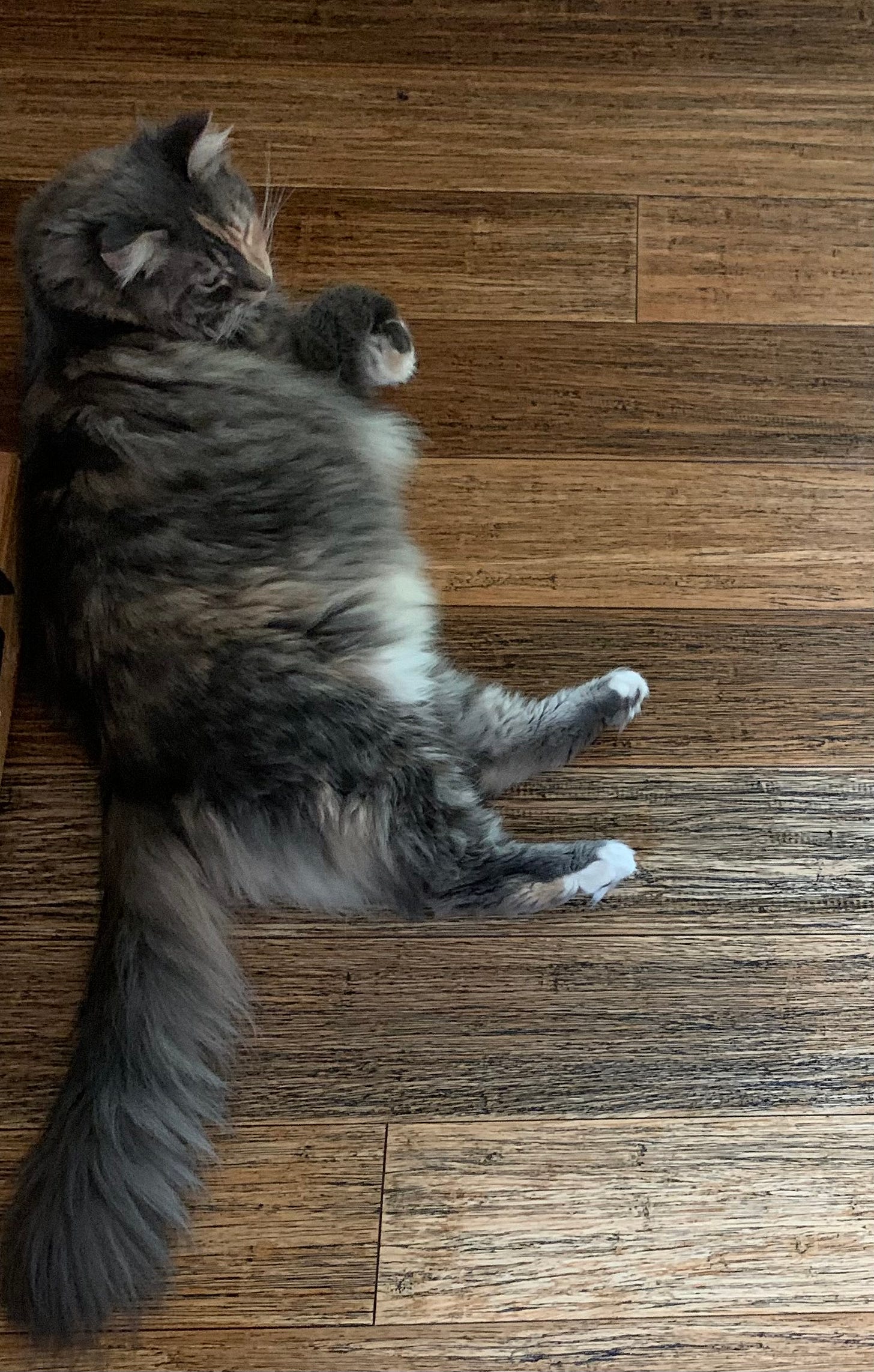What It Is, What It Was, Part 1
Heavy Hammer....
Last Week’s Bonus Round: “Ace Up My Sleeve” is a song by the band Lord Huron, written by frontman Ben Schneider, for the film “The Starling Girl” and performed by Lord Huron. Mr. Schneider also wrote the score for the film.
“Lord Huron Share New Song “Ace Up My Sleeve”
From the New Film The Starling Girl
May 19, 2023 By Mark Redfern Photography by Jones Crow
Lord Huron have shared a new song, “Ace Up My Sleeve.” It is featured in the new film The Starling Girl, which Lord Huron frontman Ben Schneider has done the score for. …
Schneider had this to say in a press release: “Being asked to compose a song that actually plays a role in the story is a dream come true for a songwriter. To have the song function in service of the narrative of such a beautiful film in that way is really special.”
The Starling Girl opened in theaters in New York and Los Angeles last week and opens in additional markets today. Laurel Parmet wrote and directed the film, which stars Eliza Scanlen, Lewis Pullman, Wrenn Schmidt, Austin Abrams, and Jimmi Simpson. …
Lord Huron’s last album Long Lost, came out in 2021 via Whispering Pines/Republic.
Read our The End interview with Lord Huron.”
Credit: Under The Radar Magazine Link: Ace Up My Sleeve
Ed. - Note: Last week’s Regular Friday Post Bonus Round clue consisted of a playlist from the Substack “Reflect and Relax ” by Marc Carrasco. Sorta unusual, but I wanted my readers to be able to connect with Marc’s fabulous Substack. Marc’s approach is unique in that he curates an ever changing playlist, while introducing readers/listeners to some awesome music that may be off the beaten Spotify track, but certainly gives one the opportunity to both reflect and relax! The song “Ace Up My Sleeve” was on the list, I liked it and just sort a picked it based on that - had no idea the song has an interesting backstory. Check out Marc’s Substack here:
This is really interesting and one that beginning and intermediate players can maybe use to discover something new. Four very easy cowboy chords, nice tempo, and the song is written in the Key of GMaj (starts off on the GMaj chord, which is generally, but not always, an indicator that it’s in the Major key, rather than the relative minor Key of Am), with a nice 103 BPM….but…
… I say “but” because it is written in 3/4 time. We so often see “common time”, (that is, 4/4 time) in blues based pop, rock, country, etc. 3/4 time is most often associated with classical waltz music, it’s even referred to as “waltz” time and you can visualize the dancer’s feet moving to a “ONE, two, three, ONE, two, three” beat. So, 3 beats to the measure, quarter note gets the beat is how you would read the signature. It’s cousin, 6/8 time - 6 beats to the measure, eighth note gets the beat, is also sometimes heard in popular modern music. At least to my ear, and your mileage may vary, even though the different time signatures are merely the “doubling” or “halving” of one another, playing 6/8 songs somehow results in a more rolling, lilting feel, where 3/4 is more, dunno, reserved (?). That may be nothing more than cultural norms, but it somehow translates to a different feel. There is an example of a church praise band song in 6/8 time (below) that always gave me that “feel” when I played it. Note that this song is clearly a 6/8 song, but Chordify’s algorithm “hears” it as 3/4 - but the rolling feel is just “different” than a waltz beat, at least to my ears and it’s kinda more evident when played. (Ed. Yeah, praise band songs lean heavily on repeated lyrics…. there’s a reason for that.)
For the Lord Huron song, there is a chord chart on Ultimate Guitar (paywall), but it’s not different from the Chordify chart in key or chords, and if you have little or no experience with making your own chord charts, this is a pretty easy one to construct. One tip: the person who created the UG chart interpreted (rightly so, I think) that the vocals come in on the “2 beat” per line. You may hear it differently, but I listened while tapping the “ONE, two, three” beat with a finger, and I think the “second beat vocals” theory is correct. Download the lyrics from Genius lyrics and see what you come up with!
Disclaimer: This Substack is free, always will be, and I receive no compensation or other benefit (except the unsolicited, occasional, and much appreciated shoutout from readers and other Substackers!) from any of the people or companies or products I link to or write about. Note some images and other material may be copyrighted by the original author or composer and appear here under the “Fair Use” doctrine. Link: Fair Use
Michael Acoustic
Thanks new subscribers! Mika, the cat, welcomes you!!
Me: “Are you going to do something about the fly that got in when you couldn’t decide if you wanted in or out?”
Mika: “No. Are you?”
Me: sigh…
Mika: “Read the comment again!”
Me: “sigh…'Such a cute kitty!’”
Mika: (stretches, purrs) “Yes. I am.”
(Ed. Thanks, Chantal!)
Yesterday I shared a link to an article: How To Use A Metronome from Mr. Griff Hamlin. Really important, and let me talk about that for a minute. The last two years or so have been difficult for musicians (not a political comment, just a fact). One way to mitigate the effects was for musicians to record in a home studio and then share those tracks with other musicians who then overdub those tracks in their studio to produce a final combined track that can be professionally mixed and mastered. That’s what I did with my song “Long Road Back”. I recorded vocals and guitar in my home studio and sent the tracks as a “WAV” file to Mellad, the guitarist, and Kenny, the drummer. They were able to record their overdubs in Kenny’s studio, then produce a near final track. I’ll talk a little about what went wrong with that process (100% MY fault!!) and how Jay our audio engineer fixed it as we go along.
BLUF (Bottom Line Up Front) - it’s critical, if you can’t record all together in one studio for whatever reason that your tracks be “on the beat” (thus, a metronome/click is a must for this) when preparing to send them to others for overdubbing, especially if you do something “different”. In my case, I like to come in on the 2 beat for vocals, it establishes the harmony (chord) and I tend to write shorter lyric lines. Well, I gotta tell my recording partners that. Yeah…. It does leave room for instrumental improv (Mellad is FABULOUS at it!!), but the other musicians kinda really need to know that.
So, creating a chord chart that conveys that, adding notes like “I come in on the 2 beat for vocals (except, for example) in the hook, or bridge, or 3rd verse” or whatever is really important. And if I do things unexpectedly, for my recording partners it’s incumbent on me to write notes on the chord chart or otherwise convey that before, or at least at the same time, I send or deliver my tracks. In my case it was on a thumb drive, and I should have put detailed recording notes in a .pdf file along with the tracks and a properly annotated chord chart. Okay, rookie mistake, lesson learned and hopefully one I can pass on to others who are using the remote overdub method of consolidating tracks.
Next I promised to talk about the writing process:
First note how I’m always going on about putting in identifiers for your music. I practice what I preach - this information (as applicable to each particular song) is on every chord chart, lyric sheet, whatever I produce, and I make sure it’s accurate.
Note: the Sound Recording Copyright, ISRC and UPC were added after I got the registration from the copyright office and then the codes from CD Baby upon release.
LONG ROAD BACK 4/4 75 BPM KEY OF AMaj NOTE: CAPO On 2
WRITER/COMPOSER MICHAEL CLAYTON HIRST ASCAP IPI 1027367371 PUBLISHER 10 SONGS MUSIC LLC ASCAP IPI 1027367273
ASCAP WORK REGISTRATION 908377871 DATE 06/29/2020
US COPYRIGHT COMPOSER/PUBLISHER # 1-9200074421 DATE 09/02/2020
US COPYRIGHT (SOUND RECORDING)# SR 956-659 DATE 05/30/23
ISWC T9330602238 ISRC: ushm82304479 UPC: 198025373053
LONG ROAD BACK
INTRO
G Am D C G
VERSE 1
G
IT’S A LONG ROAD BACK
Am
DARK AND NARROW
D
‘CROSS A BRIDGE SO WIDE
G
AND PAVED WITH SORROW
G
WHERE THE WATER ROLLS
Am
SILENT AND COLD
D
LIE THE WORDS BETWEEN
G
AND A PAIN SO OLD
© Copyright 2020, 10 Songs Music, LLC, All Rights Reserved
So, that’s the first verse. Notice the ‘hook” is right up front. The chords reflect those used in the Key of GMaj (cuz they’re easy), but I want to sing in AMaj (cuz it fits my vocals better) so the note CAPO ON 2 is right at the top - really important that it’s bold and italic with circles and arrows and a paragraph on the back if necessary to let remotely overdubbing artists know what’s going on - guitar solos/improvs will have to be in AMaj, or possibly in the relative minor of F#m, not GMaj/Em, otherwise, it’s weird. One thing I coulda/shoulda done is send a chart with chords transposed to AMaj, with an explanation that I’m capoing on 2, playing GMaj shapes, but resulting in AMaj chords, and indenting the lyrics and explaining why in the notes stuff like, “I come in on the 2 beat on each of those lines”. Lesson learned.
(Ed. The next single I’m working on now is in CMaj, so no capo and although I think I sing better in AMaj, I’m just gonna have to tough it out.)
Next week we’ll talk about how the lyrics above, which are probably not the original lyrics (it was 3 years ago, I don’t remember…), came to be what they are now and we’ll “do” the chorus, bridge and how/why I changed the chords on the third verse (felt like it…).
Shameless self promotion section
What I’m Listening2: (Might have already posted this once. Not sure, I try to keep track, but…)
Bonus Round: Nine pounds!!
Cheers and keep playing!!
Michael Acoustic






Enjoying your song. Pulled it down from iTunes. Slight hint of Chris Rea - in the best way. Thanks for sharing.
Thanks a lot for the mention, Michael!